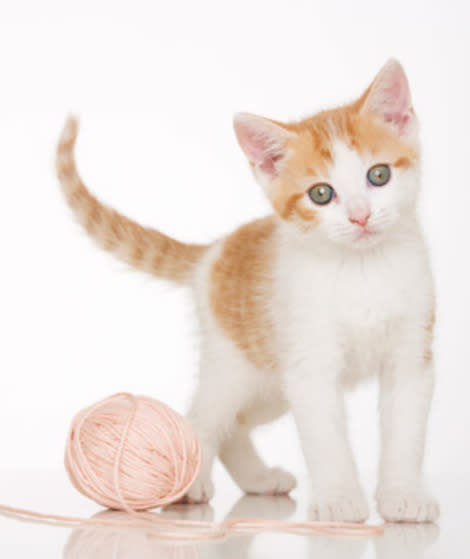How to Protect Your Pet's Health
Avoid expensive vet bills and keep Fido and Fluffy healthy with a little advance know-how and TLC.
By Brigitt Hauck
A little knowledge and a few proactive measures can help prevent-or at least minimize-some of the most common medical conditions in cats and dogs. Emmy Pointer, a veterinarian at the Bergh Memorial Animal Hospital of the ASPCA, in New York City, and Ann E. Hohenhaus, a veterinarian at the Animal Medical Center, in New York City, share simple steps pet owners can take to reduce the strain and pain these conditions cause our four-legged friends.
Also See:5 Things You Can Learn From Your Pet
Dental Disease
What it is:
As in humans, food particles and bacteria accumulate on and between an animal's teeth and gum line over time. The progressive buildup of food particles and bacteria form plaque and can lead to gingivitis and infections, causing discomfort and possible loss of teeth.
Whom it affects:
Cats and dogs.
Possible symptoms:
If your pet's breath is so bad it has you turning down his kisses, there could be an underlying dental problem. Frequent drooling, reluctance to eat, pawing at the mouth, and traces of blood on chew toys should also raise a red flag.
Treatment:
The good news is that a good cleaning, dental X-rays, extraction of infected teeth, and antibiotics can relieve most signs of dental disease. The bad news is that treatment can cost thousands of dollars.
Prevention:
It's important to brush your pet's teeth daily. All you need is a washcloth or a baby toothbrush and pet toothpaste. (Warning: The fluoride in human toothpaste can be harmful.) Consult this list of veterinarian-approved oral-hygiene products recommended by the Veterinary Oral Health Council for more information.
In addition to at-home cleanings, keep potential dental problems at bay by taking your pet for annual checkups. Your cat or dog will need general anesthesia for routine cleanings, but the process is much easier and less expensive than a dental emergency.
Also See: Foods You Shouldn't Feed Your Dog
Urinary-Tract Obstruction
What it is:
A blockage in the urethra, which prevents your pet from relieving himself.
Whom it affects:
Dogs and cats, and especially male cats.
Possible symptoms:
Consult a veterinarian if your cat is going in and out of the litter box, straining to use the litter box, crying or vocalizing in the box, urinating outside the box, or has blood in his urine. What may look like constipation could be a urinary-tract obstruction.
Treatment:
If a blockage is left untreated, toxins normally released in the urine can build up in the animal's body and cause fatal poisoning and kidney failure, so the pet must see a veterinarian immediately. The animal will be anesthetized, and a urinary catheter will be put in place to relieve the obstruction. After two to three nights, the pet can return home.
Prevention: A stress-free environment and a diet that increases water consumption, which encourages more frequent urination, may help keep urinary problems at bay. For multiple-cat families, each cat should have his or her own litter box, and there should be one extra box.
Also See:Where Should I Put a Cat-Litter Box?
Pyometra
What it is:
The uterus in a female pet becomes infected.
Who it affects:
Adult cats and more often dogs.
Possible symptoms:
Pets suffering from an infection may have vaginal discharge and an insatiable thirst, and as a result they may have to be let out more often. As the illness progresses, your pet may have a loss of appetite and vomit frequently.
Treatment:
Your veterinarian will surgically remove the animal's ovaries and uterus and prescribe antibiotics to prevent subsequent infection.
Prevention:
Because a spayed dog or cat has her uterus removed, she cannot develop the disease.
Also See: Solutions to Common Pet Problems
Gastrointestinal Foreign Body

What it is:
An inedible object, such as a fruit pit or a toy, becomes lodged in some portion of the stomach or intestines and disrupts digestion.
Whom it affects:
Cats and dogs.
Possible symptoms:
If your pet got hold of something and swallowed it, he'll probably have trouble keeping food down. Your pet may vomit, may refuse to eat, and could become lethargic.
Treatment:
If a foreign body is suspected, a veterinarian will probably take X-rays or perform a sonogram to confirm that a foreign object has been ingested. If the foreign object is in the stomach and easy to grab, it can sometimes be removed with an endoscopy. But many cases require surgery.
Prevention:
The best way avoid the vet's office is to be cautious about what's lying around the house and to keep an eye on animals while they play. Cats are often attracted to linear foreign objects, like string and hair ties, while dogs may accidently swallow toys and harmful food items, such as corncobs, fruit pits, and bones.
Also See:New Cat Owner Checklist
Click Here to See More Common Pet Health Problems
You Might Also Like:
The Best New Pet Gear
How Do I Remove Pet Hair?
Pet-Themed New Uses for Old Things
